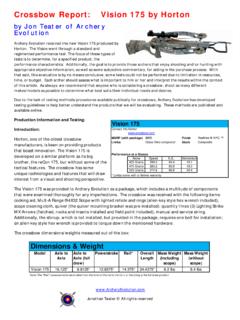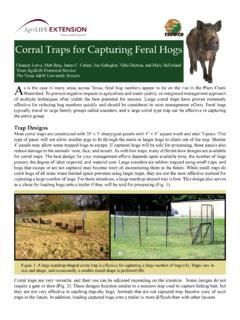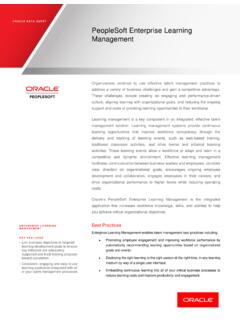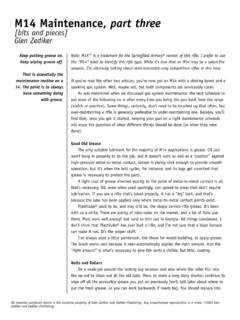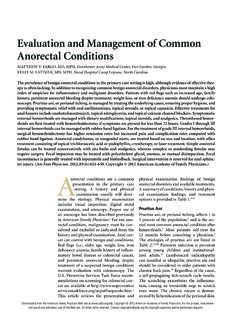Transcription of Rollover of Heavy Vehicles - ARTSA
1 72. june 2012 Chairman s Technical Column Recently, I investigated three Rollover crashes. rollovers are always serious and often life threatening. But why did these crashes occur and what can be done to avoid a Rollover ?The basics When a vehicle goes around a corner, friction between the tyres and roadway pulls the truck and trailer around the curve. If the tyre grip is inadequate, the vehicle will slide sideways. If the tyre grip is good, the vehicle might pivot over the outer tyres. The ability of a tyre to grip the road depends upon the tyre tread design and depth, and the pressure. Tyres that are in poor condition or under inflated are likely to slide rather than grip.
2 The sideways force needed to go around a corner is: Force = M V2/R. Force increases with truck/trailer mass M. V is the square of the speed and R is the inverse of the curve is critical. Increasing the speed from 60km/h to 70km/h increases the force by 136 per cent. Radius is also critical. A sudden late change in steering angle greatly increases the necessary force. If the radius is halved the force is doubled. The higher the centre of mass, the greater the overturning moment. Low suspension roll-stiffness causes the centre of mass to move out, which makes things Rollover threshold indexThe Rollover threshold is the lowest level of centrifugal acceleration which causes the truck to tip over when driven at constant speed in a curved path.
3 The index is expressed as a proportion of the acceleration due to gravity (g = m/s2). A low value is , whilst a vehicle with a low centre of gravity height (such as a truck carting plate steel) might achieve Rollover threshold can be measured on a tilt-table. The angle at which the vehicle rolls over is directly related to the centrifugal acceleration at which the vehicle would roll over on a curve. The index is called the static Rollover threshold (SRT).The Performance-Based Standards Scheme (PBS), which is now available for the certification of non-standard Heavy - vehicle designs, specifies a minimum SRT for dangerous good trucks and buses of , and for other Heavy index could also be measured dynamically by driving a test vehicle at a steady speed around a corner of known radius and determining the speed at which the inner wheels first leave the ground however, this is a difficult test to do.
4 The Dynamic Rollover Index (DRT) might be computed using simulation software but is a much more difficult calculation than for the SRT. The SRT = g (track width) / ( of C of G). For example, if a truck has an SRT = , then the critical speed at a tight round about having a radius R = 12m is x x 12 ~ 22 semi-trailer will typically roll over from the rear. That is, the trailer group will usually lift first, then the drive-axle group and then the steer axle. For combination Vehicles , the roll coupling between vehicle parts should also be considered. Interaction between vehicle parts depends upon the characteristics of the mechanical coupling, and will be different for a double axis ballrace turntable than for a fixed fifth wheel.
5 Factors to be consideredThese factors are based upon guidance given by Michael Dilich and John Goebelbecker (Truck Rollover , Triodyne Inc, Vol 6, No 1, October 1997), who give an excellent review of the factors that contribute to truck factorss%NTEREDCURVEATEXCESSIVESPEED $IDNOTANTICIPATETHESHARPNESSOFthe s$ !CCELERATEDTHROUGHTHECURVE s)NEXPERIENCEDATCARTINGHIGH#OF' ,ATECHANGEOFSTEERINGANGLE PERHAPS during an avoidance #OLLAPSEDSUSPENSION Rollover of Heavy Vehicles INmATEDTYRES s"ULKLOADSTHATMOVETOWARDSTHE outside of a #ONCRETEINAGITATORSTHATTUMBLES within the agitator into a ,OADSHIFT factorss)NADEQUATESPEEDADVISORYSIGNS s!
6 DVERSESUPER ELEVATION s3 OFTSHOULDERS s4 RANSITIONCURVESINPOORLOCATION %VERYTRANSPORTOPERATORSHOULDBEACTIVELY considering these risk factors in their business and insisting that drivers know the basics. VicRoads has had considerable success in educating the Victorian industry about ways to reduce Rollover events. A first-class DVD about Rollover risk reduction is available from VicRoads. Suspension roll stabilityThe roll stability of the rear suspension affects the Rollover index. There can be significant differences between roll stiffness of hard and soft suspensions. Roll bars have an influence. Air suspensions can have one central levelling valve or two levelling valves one on each side.
7 Levelling valves usually have slow responses. That is, it might take five seconds for the air pressure in the air bags to change following a change in ride height. An air suspension with a single levelling valve is unlikely to change the air bag pressure during cornering. If there are two levelling valves, the air suspension will attempt to adapt to the tilt across the chassis during cornering. If the valves react slowly it is unlikely that the response will be timely. A recent development that has been proven on concrete agitators ensures that two levelling valves are used. The air tubes that run to each suspension airbag are short, large diameter and equal length.
8 This seems to speed up the response to changes of chassis tilt and apparently increases the air-suspension roll roll stability control%LECTRONICROLLSTABILITYCONTROLISA viable technology for reducing Rollover propensity. It does this by slowing the vehicle down when there is an unacceptable difference between weights on the wheels on each side of the vehicle . Whilst drivers might initially complain that the system operates prematurely, even experienced drivers sometimes misjudge how close they are to rolling over on roll stability system (RSS) has two levels of operation. RSS always has a lateral accelerometer.
9 There is no response below the trigger level, which is initially set to ~ Above the trigger level, RSS conducts test brake applications independently on each side and measures the changes in wheel speed. These measurements, which are called a level 1 event, indicate how much weight-difference exists between opposite sides of the vehicle . If the vehicle has air-suspension, pressure measurements from the airbag on each side can also give useful information to the RSS. If the level 1 event indicates an unacceptable safety margin, then a level 2 response occurs. This involves application of the brakes on each side of the vehicle to slow it down.
10 The RSS should manage the brake level to prevent wheel lock-up occurring. The RSS will also broadcast instructions on the CAN bus to other Vehicles and potentially to the engine, that will facilitate co-ordination with other electronically controlled brake systems on the vehicle . An RSS is now included in a trailer ELECTRONICBRAKECONTROLSYSTEM 4R%"3 )Tis very effective and should be standard on all trailers. Operators of dangerous goods and bulk goods combinations have proven the effectiveness of roll stability technology in Australia. Roll stability response is also a standard feature of electronic stability control on trucks.


